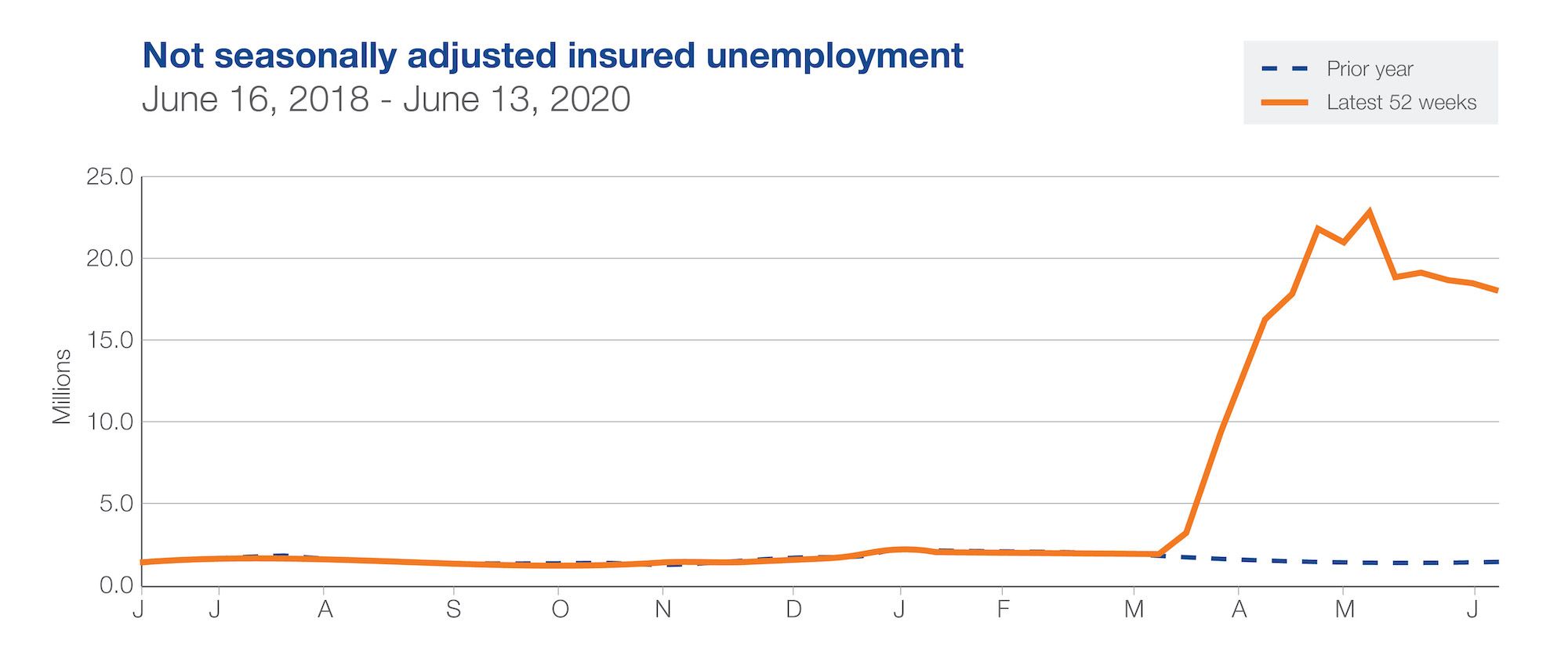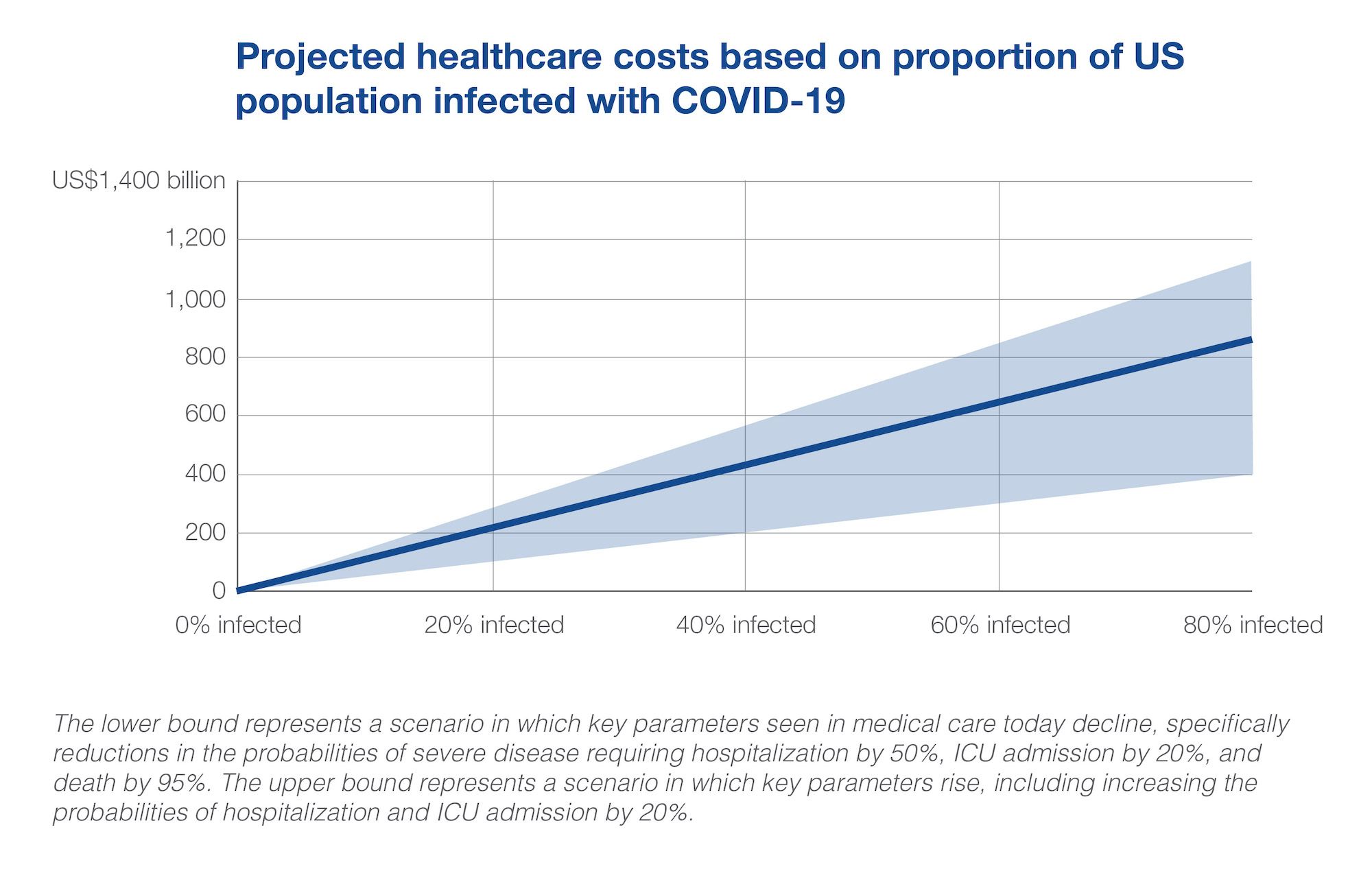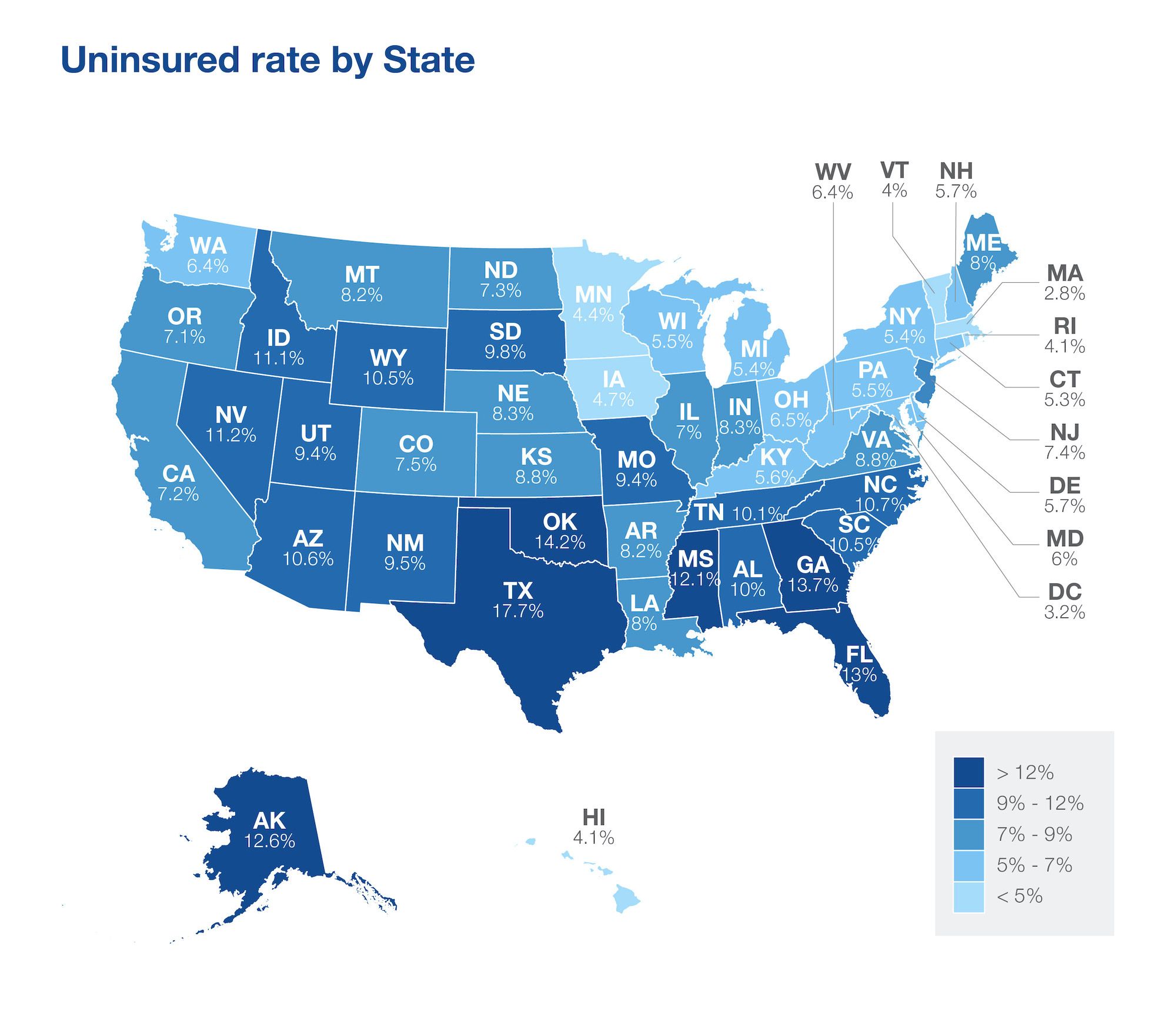How Will COVID-19 Affect the Financing of Healthcare Provision Across the US?
As providers and payers exert ever greater pressure on the pharma industry, will they force manufacturers to offer significant pricing concessions and will this become the new normal for the US healthcare system? Brett Gardiner reports.
The current coronavirus pandemic sweeping across the globe represents one of the greatest fiscal challenges to US healthcare policymakers in modern times. The Federal Reserve expects the US economy to contract by a staggering 6.5% this year, with approximately 20 million Americans unemployed and many more without medical insurance.
Click to enlarge.

The eventual impact will depend on the proportion of the US population infected with the SARS-CoV-2 virus. As the infection rate rises, additional healthcare expenditure will be required to treat patients whilst prolonged economic lockdowns will become ever more necessary. Such lockdowns will inevitably cause further job losses, with the newly unemployed also losing their medical insurance and being less able to pay for their healthcare. Fewer businesses, and fewer still making a profit, will result in reduced tax revenues for the Federal government and in turn healthcare funding will suffer.
Click to enlarge.

The anticipated increase in direct medical costs as rates of infection rise demonstrate not only the importance of bringing the virus under control, but the necessity for payers to take a flexible approach to management of healthcare costs. A careful balance needs to be struck to ensure sufficient resources are available to treat COVID-19 while adequate funding remains available for the treatment of other conditions.
Payers’ expectations regarding the economic impact to the US healthcare system caused by COVID-19 was one of a number of areas explored by Research Partnership in the first wave of a syndicated study to assess the impact of COVID-19 on biopharmaceutical market access. Interviews were conducted with payers and advisors in the US,1 Europe, Brazil, and China during April and May 2020.
US healthcare funding during COVID-19
The Coronavirus Aid, Relief and Economic Security Act
In March, President Trump signed a $2 trillion bill with the intention of stimulating the US economy and protecting workers from loss of income. This package included $150 billion to help support hospitals and medical workers in the fight against COVID-19. $100 billion was allocated to the Public Health and Social Services Emergency Fund, to be made available to eligible health care providers for expenses or lost revenue associated with the epidemic. Furthermore, $1.32 billion was allocated to supplemental funding for community health centers for prevention, diagnostic and treatment efforts related to COVID-19; as well as introducing additional payments for hospitals treating COVID-19 patients, such as creation of a 20% add on payment for hospitals treating Medicare inpatients with COVID-19.
Despite such large sums of money being allocated to providers, many are facing substantial cash shortfalls due to the cancellation of elective procedures on which many rely to generate their income. Paradoxically, some less well-funded institutions have been forced to put their staff on leave in order to make ends meet during the pandemic, increasing the already significant workload burden on remaining colleagues.
Given the desire amongst providers to avoid costly lockdowns, they are likely to be supportive of funding technologies that can potentially reduce the impact of future outbreaks.
The first wave of budget allocation ($30 billion) has been distributed to providers based on Medicare billings. This disfavors providers who treat large volumes of poorer patients, as these individuals would not fall under Medicare. In response to this, the US government has stated that the next wave of distributions will go to providers in COVID-19 hotspots, rural hotspots and groups that predominantly treat less well-off patients under Medicaid. Providers are concerned that poor management of funding distribution will mean many organizations fold before they receive the money for which they would otherwise be eligible.
BARDA funding
Separately to the President’s stimulus package, the Biomedical Advanced Research and Development Authority (BARDA) – a US Department of Health and Human Services office – has been allocating hundreds of millions of dollars to fund and procure COVID-19 medical countermeasures. These range from novel vaccines (including those in development by AstraZeneca, Janssen, Moderna, Merck and Sanofi) to modelling algorithms.
Both the pharmaceutical industry and providers / health plans welcome this funding, given the urgent need for prevention strategies that have the potential to mitigate increased healthcare expenditure. However, with such visible public funding of the research efforts, the American public is expected to hold the pharmaceutical industry to account; especially as funding is coming from their hard-earned tax dollars.
Impact of COVID-19 on healthcare funding
Impacts on Medicare/Medicaid vs. Commercial
Data from the US Census Bureau indicates that a total of 27.5 million Americans had no health insurance during 2018; this number is expected to rocket as patients lose their jobs and commercial health insurance. Some of these individuals will be eligible for Medicaid support but many will not meet the criteria2 for enrolment.
The distribution of uninsured patients by state varies significantly. To date, the more affluent Northeastern seaboard has suffered from particularly high levels of SARS-CoV-2 infections while the southern states have experienced much lower levels of infection. However, as SARS-CoV-2 continues to sweep across the US, it is the southern states with high numbers of uninsured Americans and at risk BAME (black, Asian and minority ethinic) individuals that could ultimately be hardest hit. Pressure will continue to grow on the already hard-pressed state Medicaid and may require individual states to step in and allocate additional funds to support their struggling healthcare systems through the pandemic, as states such as NYC and New Hampshire have done.
Click to enlarge.

Payers across the commercial and Medicare/Medicaid divide have been forced to consider how best to plug the holes in their budgets. Those in our study expected increased member insurance premiums to be the most manageable way of achieving this. Payers are aware that members are more sensitive to increases in co-pay than they are to increased premiums, and conscious of the potential for negative PR should significant rises be required. Their desire to minimize the immediate impact on members was evidenced by suspension of all co-pays for telehealth services until the situation normalizes.
However, insurance premiums have already been following an upward trajectory in recent years so members have become accustomed to annual price hikes. The drive to increase premiums is also coming from employers themselves, as many businesses that do survive lockdown and the subsequent economic downturn are not going to have the same level of financial resources they did before the pandemic. This means employers will be more reluctant to pay higher insurance contributions to fund high-cost products such as cell and gene therapies or oncology agents. Employers (along with payers and insurance brokers) are therefore lobbying Pharmacy Benefit Managers (PBMs) to ensure treatment costs are shouldered by the patient in the form of higher premiums.
State Medicaid payers have been looking into the unprecedented step of introducing a $10 monthly premium for low-income earners, as well as the possibility of introducing a Medicare New Technology Add-on Payment (NTAP) for COVID-19 therapies to deal with the added costs of these treatments.
The federal 340B drug pricing program obliges manufacturers participating in Medicaid to provide outpatient drugs (but not vaccines) to eligible healthcare organizations at significantly reduced prices. Providers acquire the drugs at discounted rates and are reimbursed the full price of the medication by insurers, generating a profit. Applications from providers to participate in this program are anticipated to increase as COVID-19 slashes their revenues and providers look at other ways of generating income.
Broadly speaking, commercial plans benefit from a younger, fitter population who are less likely to be severely impacted by COVID-19. This, in conjunction with the loss of many individuals from their plans due to job losses, may result in commercial payers having less willingness to fund COVID-19 technologies than Medicare/Medicaid payers. However, during the course of the research it was noted that commercial payers would be just as willing to finance and fund a SARS-CoV-2 vaccine as Medicare/Medicaid payers, driven by expectations that the Federal Government may fund vaccine provision and the desire of their members to have access to a vaccine.
On 16 June, Trump pledged SARS-CoV-2 vaccinations would be free for ‘vulnerable’ Americans who are unable to afford them. The key questions will be who is considered ‘vulnerable’ and who is considered to fall into the ‘cannot afford’ category, with an emphasis likely to be placed on Medicare / Medicaid patients.
As with the rollout of the H1N1 vaccine, government officials have stated that they anticipate a ‘tiered approach’ for distributing a SARS-CoV-2 vaccine with priority given to high-risk individuals such as the elderly, those with pre-existing health conditions and frontline healthcare workers.
According to the insights from the study, even in the absence of federal funding, commercial stakeholders would still consider offering vaccination against SARS-CoV-2 without co-pay as a way of retaining and attracting new members to their plans.
Another important consideration that will directly impact on vaccine uptake in the Medicare sector is whether the vaccine will be classified under Medicare Part B or Part D. Many new high cost vaccines such as Shingrix have been included under Medicare Part D, which requires a patient co-pay and administration fee. This is in contrast to Part B, where older, universal vaccines (i.e. pneumococcal and seasonal influenza) are expected to be covered with no co-pay. Should any SARS-CoV-2 vaccines be listed under Part D, the out-of-pocket costs will likely deter some patients and may hamper sufficient vaccination coverage rates being achieved in the most vulnerable, elderly population.
Few payers in the study appeared to have considered the potential for vaccination coverage rates to be used as a quality measure. For those with high potential for their organizations to be publicly rated on this metric (e.g. the STAR ratings associated with Medicare plans) there is potentially an extra incentive to secure a vaccine that can be widely adopted.
More aggressive pricing negotiations with manufacturers
Under normal circumstances, pricing of pharmaceuticals may be negotiated between payers and manufacturers and is predominantly based on the interplay between value (inclusive of R&D costs) and budget impact.
For COVID-19 technologies, speed is of the essence; bringing safe and effective therapies to market and pricing negotiations should be wrapped up as quickly as possible to ensure patient access is achieved without delay. Many payers therefore believe now is not the time to deviate from classical contracting agreements such as flat discounts.
That said, innovative contracting agreements and more aggressive rebates are expected to become increasingly relevant in other areas as payers look to implement cost-containment measures to help balance their books and offset the costs of COVID-19. This will be particularly relevant to high-cost therapy areas such as cell and gene therapy and oncology, where prices of half a million dollars or more will no longer sit well. Payers expect they will need to drive a hard bargain in these areas.
Re-negotiation of existing contracts will be another important tool for payers looking to offset the increase in expenditure for COVID-19 moving forwards. As new products launch, existing market leaders should expect tough competition and negotiation driven by payers, who expect to increasingly re-visit their contracts and actively pursue higher rebates for existing therapies in areas such as oncology, HIV & hemophilia in search of greater value.
Conclusion
As providers and payers find themselves squeezed and forced to exert ever greater pressure on the pharmaceutical industry, the question is can they come together in order to force manufacturers to offer significant pricing concessions and if so, will this become the new normal for the US healthcare system?
Looking to the future, manufacturers will need to take a more strategic approach to their portfolio planning, rationalizing future R&D efforts across all therapy areas, considering which offer scope for savings to be made and which do not. Therapies that are maintenance in nature and given in the in-patient setting during elective procedures have seen a huge decrease. On the other hand, therapies that society feels are essential regardless of price or what is going on in the world have continued to sell well through the pandemic.
As Congress weighs up the merits of a second stimulus package to be launched later this summer, they must consider how the previous package has been rolled out and the impact it has had on insurers and providers. Politics will inevitably play into the decision: with a presidential election on the horizon, politicians will be especially sensitive to the needs and wants of their voters.
Even prior to the pandemic, President Trump has launched a series of attacks on the pharmaceutical industry, with partisan pressure gaining momentum and legislation mooted that would force the industry to lower drug prices. However, with COVID-19 anticipated to trigger one of the worst recessions in living memory, and the positive impact on perceptions of the industry that could be achieved by manufacturers who launch COVID-19 technologies, the pressure on drug companies may potentially decrease as voters turn their attention to other topics.
George Forsyth is Associate Consultant, Market Access, Research Partnership.
About the study
Click here to find out more about the first wave of the syndicated report, which includes detailed information on a range of topics, including detailed specifics regarding how US payer and provider segments have been impacted by COVID-19 and their anticipated future approaches to cost containment.
Notes
1. Within the US, Research Partnership interviewed a total of 30 payers and providers, plus 5 ACIP members. Payers were selected from Managed Care Organizations, both Commercial and Medicare, along with Medicaid representatives, both state and managed. Providers with no sponsored insurance component, as well as those with insurance (Integrated Delivery Networks and Provider Sponsored Health Plans) were included, with representation from the plan and the delivery side. All segments included a mix of pharmacy benefit and medical benefit perspectives, and payers from a mix of national and regional plans were included, with regional representation focused on urban centers and states that had been particularly affected by COVID-19 to date. Research Partnership also spoke to a handful of Pharmacy Benefit Managers.
2. www.medicaid.gov/medicaid/eligibility/index.html
Sources
https://www.ft.com/content/3bbb4f7c-890e-11ea-a01c-a28a3e3fbd33
https://www.sciencedaily.com/releases/2020/04/200423160512.htm
https://www.advisory.com/daily-briefing/2020/03/30/trump-stimulus
https://heatinformatics.com/posts/covid-19-cost-scenario-modeling-treatment
https://www.phe.gov/emergency/events/COVID19/Pages/default.aspx
https://policyadvice.net/health-insurance/insights/how-many-americans-are-uninsured/
https://www.hrsa.gov/opa/COVID-19-resources
https://www.healthaffairs.org/do/10.1377/hblog20180807.985552/full/
Navigating Distrust: Pharma in the Age of Social Media
February 18th 2025Ian Baer, Founder and CEO of Sooth, discusses how the growing distrust in social media will impact industry marketing strategies and the relationships between pharmaceutical companies and the patients they aim to serve. He also explains dark social, how to combat misinformation, closing the trust gap, and more.